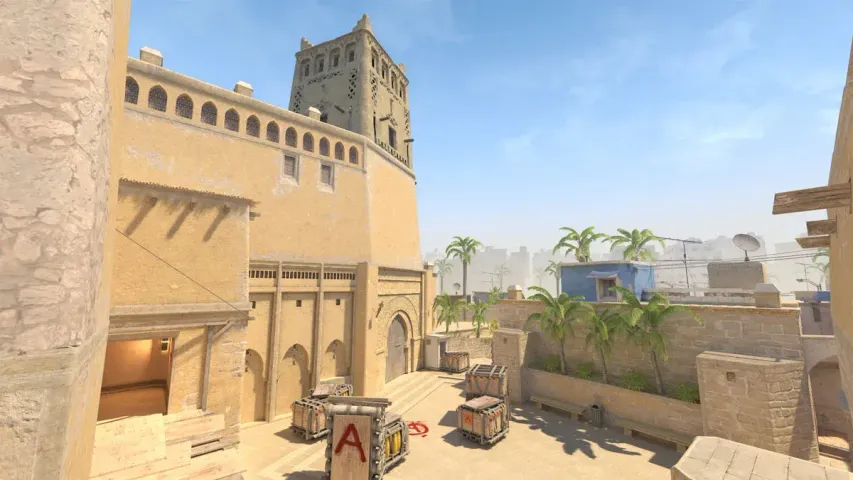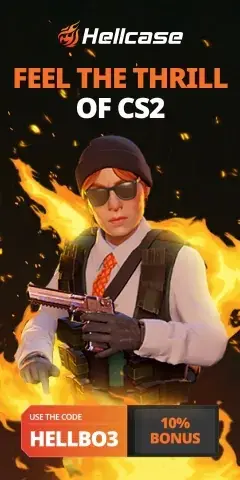
Mirage
Mirage, released in 2013 as de_mirage in Counter-Strike: Global Offensive, is a reimagining of the de_cpl_strike map from previous versions of the game. Created by Valve Corporation, it was developed based on the design of Michael "Bubkez" Hüll, making the map one of the most popular and respected in CS:GO, used in many eSports tournaments and Majors.
Mirage excels in its balance and provides players with extensive opportunities to demonstrate tactical and coordination skills. Valve regularly updates the map in an effort to improve its quality and tactical balance.
History of the map's creation
The history of the map began back in the era of Counter-Strike and Counter-Strike: Source, where it was known as de_cpl_strike. In 2013, Valve reworked the map and included it in CS:GO as de_mirage, quickly establishing itself as one of the three most popular maps in competitive play and matchmaking. And with the transition to CS2, the card is still listed in the active mappool.
Community feedback and improved textures and lighting were aimed at improving the game's readability, while changes to the setting added a unique feel to the map compared to previous versions.
Mirage's design follows the traditional design of Counter-Strike maps such as Dust II, Cache and Inferno, and features a Middle Eastern style city with various buildings and structures. The map is structured around two bomb sites connected to the mid lane, making it similar to other maps with a clearing layout.

Mirage has long been a favorite among players and critics alike due to its simple structure and continuity. It has been recognized for its balance, unique visual style and low barrier to entry, making it a mainstay in the professional game and causing numerous upsets. Mirage is also highly regarded for its ability to teach strategy, requiring players to know about rotations and map control.
However, by 2022, the map had faced criticism for being stagnant in the meta, with pro teams often repeating the same strategies due to a lack of updates since 2020. Despite this, Mirage remains one of the most played and optimized maps in CS2, as evidenced by its presence in every Counter-Strike Major.
Interesting Facts
The map has unique elements, such as two TVs with SMPTE color bars that stop working when attacked, and graffiti honoring the famous moment with Marcelo "coldzera" David at MLG Columbus 2016. Mirage. Despite its Moroccan appearance, it contains interesting Easter eggs, such as a car with an American license plate outside the playing area, which adds color and depth to the picture.
Overall, Mirage is a living testament to the evolution of Counter-Strike, its ability to adapt and remain relevant to players of all levels. The map continues to inspire new strategies and tactics, maintaining its place in the hearts of CS2 fans around the world.

Map developers
Many people and studios contributed to the creation of the already legendary Mirage, namely:
- Cyberathlete Professional
- League (original author)
- Michael Hull (original author)
- Valve Corporation
Mirage Callouts in CS2
Now let's move on to the main places on the Mirage map:
- A Site (or Bombsite A) - First place to plant a bomb
- B Site (or Bombsite B) - Second place to plant a bomb
- Center (Mid) Spacious open area in the middle of the map
To improve the quality of your game and understanding of the Mirage map, you need to study the features of Bombsite A, Bombsite B and Center (Mid). These three critical locations offer a variety of challenges and opportunities for the Counter-Terrorist (CT) and Terrorist (T) sides.
Bombsite A is a small room with four open entrances, providing limited hiding options and sometimes creating confusion.

In contrast, Bombsite B is adjacent to the Kitchen, Apartment B and Underground, providing multiple access routes such as through a Mall door or window. Defenders often need to move around this zone to effectively defend it.
In any map, Mid acts as a key battle arena, where both teams fight for control and access to other parts of the map. It serves as an important crossroads connecting both bombsites.
The importance of controlling the Center lies in its ability to provide vital information about enemy movements and facilitate rapid transfers between points for both sides.
To increase your coordination and chances of success in assaulting and defending key locations on the Mirage, it is vital to know all the directions, including those that are unique to your team.





![Rumors: Eternal Fire May Sign Woro2k [Updated]](https://image-proxy.bo3.gg/uploads/news/383686/title_image_square/webp-d3ae22b1a1a2a2a92db53d3d6a8cf14d.webp.webp?w=60&h=60)
